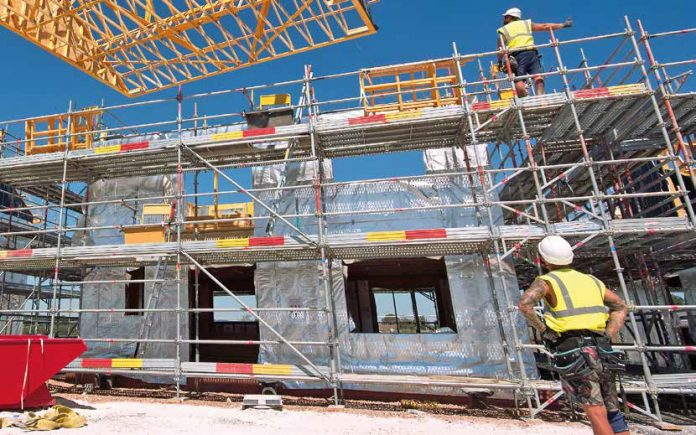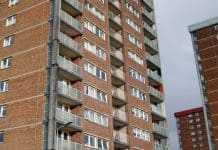While most of us will have been glad to say goodbye to 2020, the year ahead is marked with uncertainty. With current events moving so rapidly, it’s hard to make predictions about what the future holds for the construction industry. Nevertheless, Andrew Orriss from the Structural Timber Association gives his views on the key priorities for the timber and MMC sectors in the coming months
This time last year, who could have imagined the events that were about to unfold?
If the overwhelming theme of 2020 was one of unprecedented challenges, it seems that 2021 will be about navigating the unknown, as we collectively find our way forwards through the third national lockdown and the uncertainties that follow our departure from the EU.
Yet challenging times by their very nature provide an opportunity to innovate, with the need to find novel solutions to new and existing problems. The pandemic has thrown the housing crisis into sharp relief, for example, with stay-at-home orders underlining the urgent need to improve the country’s supply of affordable social housing.
The Prime Minister has been firm in his ambition to “build, build, build” but we also must not drop the ball in terms of vital carbon reduction targets. So, while the coming year may well have its challenges, it’s crucial that the industry seizes this opportunity to adopt faster, more effective and more sustainable ways of working.
Building back greener
“Greener buildings” have been identified as one of the key points in the government’s 10-point plan towards a Green Industrial Revolution. Therefore, the environmental performance of the construction industry is likely to come under increasing scrutiny throughout 2021.
Indeed, within the plan itself, the government has committed to setting out both its Heat & Buildings Strategy and its energy-related products policy framework during the coming year. It’s likely that these policy items will emphasise the use of low carbon, sustainable materials and increased adoption of efficient construction techniques.
What’s more, with the 2025 Future Homes Standard drawing closer, the next 12 months are part of an important preparation period for developers embarking on the journey towards meeting their net-zero targets. To best meet this goal, national authorities must reconsider current plans, which overlook the importance of building fabric energy efficiency and instead overly focus on the role of low carbon domestic energy sources.
While we applaud any efforts to make new homes low carbon, energy efficiency must be paramount and such contemporary policies mustn’t upend existing progress within this essential area. To this end, we’re part of an extensive group of construction professionals who are calling for revisions to forthcoming changes in the Building Regulations.
These changes include the preservation of the Fabric Energy Efficiency Standard and a greater recognition of embodied carbon measurements when determining a building’s green credentials.
With this increasing focus on efficiency of the fabric of the building, the use of timber frame and structural insulated panel construction can offer a good deal of external wall flexibility when the demands for high thermal insulation are required. In simple terms, it is easier to fill the building envelope with insulation in a structural timber internal leaf, than filling a cavity between two traditional masonry wall skins.
In addition to these benefits, structural timber has a key role to play in reducing the overall carbon emissions of the construction industry, thanks to the carbon storage potential of timber harvest crops. By comparison, a report published by Chatham House (Making Concrete Change: June 2018) shows that cement is the source of 4%-8% of total global carbon dioxide emissions. In fact, when used instead of other building materials, a single cubic metre of timber will save around 0.8 tonnes of carbon dioxide emissions.
Tackling misconceptions
We find ourselves at a crossroads at the start of 2021: with ambitious environmental deadlines looming, the obvious solution is to increase the use of renewable, sustainable and environmentally positive materials such as timber, but a lack of understanding and support from the insurance and financial sectors has become something of a stumbling block in securing backing for this type of project.
The construction industry has a tremendous opportunity to make a significant and meaningful contribution to the delivery of the whole climate change agenda. Timber is the primary building material that will help the country reach its carbon targets: it is sustainable, replenishable and can be positively recycled at the end of use.
Opponents may point to the risk of fire; however, this is to ignore the body of evidence that exists regarding the very predictable nature of timber and how it performs. Furthermore, the impact of good design, engineering, detailing and construction has been wilfully overlooked.
As such misconceptions around timber’s suitability as a construction material have meant that this versatile solution is still considered a risk by certain insurers and finance houses. This basic misunderstanding of the facts could be jeopardising the future of the economy and the environment. Consequently, there is a real risk that we will not meet these targets and the opportunity to address the global climate change issue will be lost.
While timber is the chosen building material for many of the country’s leading housebuilders, there is a whole world of construction that could benefit from the learnings this progressive sector has made by adopting offsite and MMC techniques. These insights could have a profound effect if they are extended to the wider construction market, where the full impact of timber on the carbon footprint of a project will have a demonstrable benefit.
Last year, the Structural Timber Association launched the Time for Timber campaign, which brings together key stakeholders from around the construction, housebuilding and timber sectors. The goal is to directly target the financial and insurance industries to counter the misconceptions around timber and deliver a compelling narrative about its place in the sustainable buildings of our future.
Driving investment in timber remains a focus throughout 2021 and beyond, for the prosperity of the country and its residents, for employment, for the economy and – ultimately – for safeguarding the environment, today and tomorrow.
To find out more about the Structural Timber Association please visit www.structuraltimber.co.uk and for more information on the Time for Timber campaign please visit www.timefortimber.org.
Andrew Orriss
Director, STA Assure
Tel: +44 (0)1259 272140
Twitter: @STAtimber
LinkedIn: Structural Timber Association














